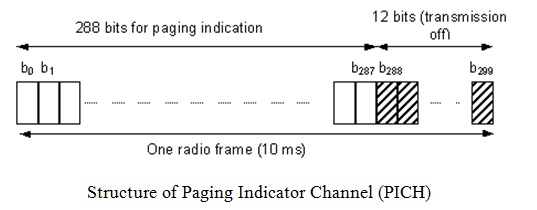Paging: - The Paging Channel (PCH) is a downlink transport channel. The PCH is always transmitted over the entire cell. The transmission of the PCH is associated with the transmission of physical-layer generated Paging Indicators, to support efficient sleep-mode procedures.
Paging Channel selection : - System information block type 5 (SIB 5) defines common channels to be employed in Idle mode. In a cell, a single or several PCHs may be established. Each Secondary Common Control Physical Channel (SCCPCH) indicated to the UE in system information may carry up to one PCH. Thus, for each defined PCH there is one uniquely associated PICH also indicated.
In case that more than a single PCH and associated PICH are defined in SIB 5, the UE shall perform a selection according to the following rule:
- The UE shall select a SCCPCH from the ones listed in SIB 5 based on IMSI as follows:
"Index of selected SCCPCH" = IMSI mod K,
where K is equal to the number of listed SCCPCHs which carry a PCH (i.e. SCCPCHs carrying FACH only shall not be counted). These SCCPCHs shall be indexed in the order of their occurrence in SIB 5 from 0 to K-1.
- The UE may use Discontinuous Reception (DRX) in idle mode in order to reduce power consumption. When DRX is used the UE needs only to monitor one Page Indicator, PI, in one Paging Occasion per DRX cycle.
The Paging Indicator Channel (PICH) is a fixed rate (SF=256) physical channel used to carry the paging indicators. The PICH is always associated with an S-CCPCH to which a PCH transport channel is mapped. Picture below illustrates the frame structure of the PICH. One PICH radio frame of length 10 ms consists of 300 bits. Of these, 288 bits are used to carry paging indicators. The remaining 12 bits are not formally part of the PICH and shall not be transmitted (DTX). The part of the frame with no transmission is reserved for possible future use.

